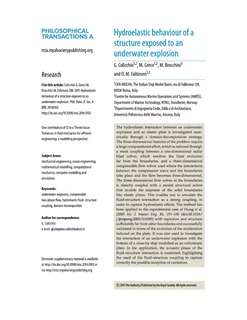| dc.contributor.author | Colicchio, Giuseppina | |
| dc.contributor.author | Greco, Marilena | |
| dc.contributor.author | Brocchini, Maurizio | |
| dc.contributor.author | Faltinsen, Odd Magnus | |
| dc.date.accessioned | 2018-03-13T12:15:30Z | |
| dc.date.available | 2018-03-13T12:15:30Z | |
| dc.date.created | 2015-01-09T08:46:48Z | |
| dc.date.issued | 2015 | |
| dc.identifier.citation | Philosophical Transactions of the Royal Society A: Mathematical, Physical and Engineering Sciences. 2015, 373:20140103 (2033), . | nb_NO |
| dc.identifier.issn | 1364-503X | |
| dc.identifier.uri | http://hdl.handle.net/11250/2490297 | |
| dc.description.abstract | The hydroelastic interaction between an underwater explosion and an elastic plate is investigated num- erically through a domain-decomposition strategy. The three-dimensional features of the problem require a large computational effort, which is reduced through a weak coupling between a one-dimensional radial blast solver, which resolves the blast evolution far from the boundaries, and a three-dimensional compressible flow solver used where the interactions between the compression wave and the boundaries take place and the flow becomes three-dimensional. The three-dimensional flow solver at the boundaries is directly coupled with a modal structural solver that models the response of the solid boundaries like elastic plates. This enables one to simulate the fluid–structure interaction as a strong coupling, in order to capture hydroelastic effects. The method has been applied to the experimental case of Hung et al. (2005 Int. J. Impact Eng. 31, 151–168 (doi:10.1016/j.ijimpeng.2003.10.039)) with explosion and structure sufficiently far from other boundaries and successfully validated in terms of the evolution of the acceleration induced on the plate. It was also used to investigate the interaction of an underwater explosion with the bottom of a close-by ship modelled as an orthotropic plate. In the application, the acoustic phase of the fluid–structure interaction is examined, highlighting the need of the fluid–structure coupling to capture correctly the possible inception of cavitation. | nb_NO |
| dc.language.iso | eng | nb_NO |
| dc.publisher | The Royal Society | nb_NO |
| dc.title | Hydroelastic behaviour of a structure exposed to an underwater explosion | nb_NO |
| dc.type | Journal article | nb_NO |
| dc.type | Peer reviewed | nb_NO |
| dc.description.version | publishedVersion | nb_NO |
| dc.source.pagenumber | 17 | nb_NO |
| dc.source.volume | 373:20140103 | nb_NO |
| dc.source.journal | Philosophical Transactions of the Royal Society A: Mathematical, Physical and Engineering Sciences | nb_NO |
| dc.source.issue | 2033 | nb_NO |
| dc.identifier.doi | 10.1098/rsta.2014.0103 | |
| dc.identifier.cristin | 1193590 | |
| dc.relation.project | Norges forskningsråd: 223254 | nb_NO |
| dc.description.localcode | © 2014 The Author(s) Published by the Royal Society. All rights reserved. | nb_NO |
| cristin.unitcode | 194,64,20,0 | |
| cristin.unitname | Institutt for marin teknikk | |
| cristin.ispublished | true | |
| cristin.fulltext | postprint | |
| cristin.qualitycode | 1 | |
